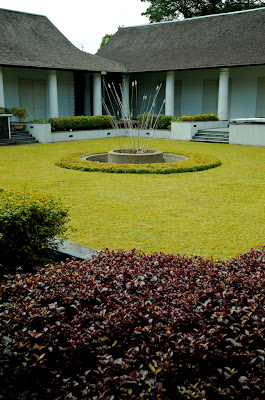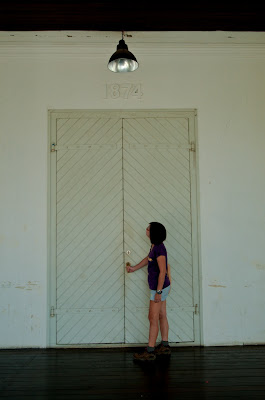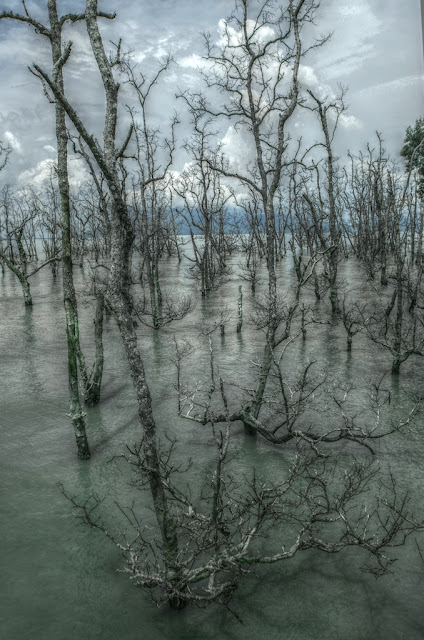Proboscis Monkeys. That’s what Sharon wanted very much to see. I was quite keen to see The Seastack, that rock formation in all the marketing literature for Bako national Park. In the end we did see most of what we set out to see, and with a few unexpected things thrown in too.
Adrian was going to guide us on the way towards Bako, along with a Canadian couple who were staying in Adrian’s Bungalow. As things turned out, instead of following his car for a few minutes onto the new highway - he’d offered as the shortcut was not recorded on the GPS - we ended driving mile after mile behind him… right up to Bako itself. Turns out he just wanted to make sure all arrangements were made properly as the Canadian couple were staying overnight. It was really very nice of him and this is Adrian for you: perhaps a little gruff and imposing on the outside but really a very warm and generous person once you get to know him.
At the town jetty we met Ismadi who was to be our guide. As we were to discover, here was a remarkable individual who’d had to deal with the constraints of a limited formal education and yet had managed to make something of his life. After Sarawak Forestry, the authority looking after the national parks in the state, mandated training and certification for tour guides, Ismadi went back to school as it were. An intensive course ensued and despite the very tight time frame and his struggle with Latin Scientific names, he passed, got his tour guide licence and could now take people around the parks.
He was from the area - the kampung near the park HQ in fact - and thus lent a lot of local knowledge to his presentation. The first thing we did after paying our fee and introducing ourselves was to get into a small boat. Life jackets donned, we headed out along the river. Bako can only be accessed by sea and this has helped keep the park secure. The land borders are porous of course but not having to deal with incursions from all sides has helped keep poaching minimal. How do I know this? Ismadi of course, who kept up a regular, and not unpleasant, commentary along the way.
Sharon all set to see her Proboscis Monkeys
Mei all set for... whatever the day had to offer.
These are fishing traps. Nets strung between the poles catch fish while the fisherman get to do other important things. Like napping in the afternoon...
No, that's not a sea serpent. It's a leftover pipe used previously for dredging. It's now painted in stripes for safety reasons.
What shape do you see? The head of a turtle, or a dragon, perhaps?
We arrived at the Bako National Park entrance, having spotted some interesting rock formations and flora along the way. I noticed a clump of dying mangrove on one side and Ismadi later explained the reason for this. After landing, we headed to the park HQ, a well-kept semi-modern building, where we bought our tickets. The park system in Sarawak is quite good as you buy a daily ticket which allows you entry to any of the parks on the day. So if you’re doing two parks or wildlife reserves in one day you only need to buy one ticket for both.
As we approached the park HQ that morning, we noticed freely roaming wild boar. They were just like stray dogs, roaming around quite unafraid of the humans who shared the grounds. I was taking pictures of one small group when one sow did a long, slow sttttrrreetttcccchhhh then suddenly lay down on her side as another pig came over and nuzzled her. She continued nuzzling her and the prone pig seemed to enjoy this. She was eventually turned through 90º by the nuzzling which I can only imagine was some sort of relaxing massage. Made me a little envious I must admit…
The wild boar are really not so wild - they're more like stray dogs.
A pit viper coiled up in some branches.
This fella came ambling along with a group then suddenly stretched out and got a muzzle nuzzle massage.
You can rent chalets which are set very prettily amongst the greenery.
A view of the camping ground, showing the wooden fence and gate which keeps the wild boar out.
We came across this family wandering along.
The little ones are learning how to fend for themselves are were obviously less adept at digging for food.
A very thorny plant.
Fiddler crabs - the males and females have large claws on opposite sides. I forget which is which.
Ismadi showed us around the park HQ. There were chalets you can rent, and even a campsite protected from the pigs by a wooden fence and gate. As we rounded the area, we came upon a sow and her piglets. These looked really quite cute, running alongside their larger mother. We came within inches of this group shoe were unperturbed and just went about their business nonchalantly. The sow was digging in the ground with her snout, hunting for food, while the younger ones were obviously less adept at this. Quite enchanting watching them, really.
After this little tour, we walked along the boardwalk where Ismadi explained one reason the mangrove we had spotted were dying was quite simply erosion. I’ve seen this phenomenon at a number of other coastal areas most notably in Kukup and Tanjung Piai in Johor where the increased shipping results in larger and more constant waves - the wash from passing ships - pounding the shore and removing sand.
As we walked into the forested areas, Ismadi constantly drew our attention to various things and explained them in some detail. We saw stingless bees whose ‘honey’ encrusts into a multi-use wax-like substance. If burnt, this is apparently an like incense - but completely naturally replaceable unlike the synthetic stuff that is used nowadays.
We also saw a very interesting rock face. Clearly embedded in this are hundreds of seashells and barnacles, clear evidence that all this was once under the sea and pushed up through the millennia into the mountain range it now is.
Another HDR shot - this one of the dying mangrove.
Termites having a ball.
Stingless bees whose encrusted nest makes good natural incense.
Nature lays out beautiful shapes and patterns.
A large rock balanced atop another.
This area was once submerged beneath the sea.
As we hiked along we noticed how beautiful the natural shapes were - the textures and patterns of leaves, the intricate weaving of tree roots and even the criss-crossing of branches and fallen trunks. Nature certainly is not just an architect or an engineer, but also an artist creatively working both in shapes and in time.
This last one we could plainly see after we sat on the beach and finally saw our only glimpse of a Proboscis Monkey sitting high atop a tree. This fella sat facing away from us, fast asleep in the midday sun. It didn’t move and wasn’t joined by any other, so Sharon’s wish only came partially true.
Our one view of a Proboscis Monkey.
Back to nature working in time - as we took to our boat and set off again, we could see the multi-layer and multi-colour cross-sections of the rock formations. Mainly crumbly sandstone, these evolve over time, shaped by the wind and waves and by geological movement. We stopped by the famous sea stack and despite slightly choppy seas managed to go around and view it from all sides. Smaller than I had originally thought, it was still a sizeable edifice but its narrow base belied the inevitable truth: that one day it will fall back into the sea, an art piece that stood for thousands of years and then was erased by nature’s hand in favour perhaps of some other creation.
There certainly were many shapes to pick out among the rock formations. And we also saw a huge bird high up in the sky. I can only say the wingspan was a majestic 2 metres or so but being no ornithologist, cannot describe it much beyond that. It circled slowly overhead, with hardly a wingbeat, serenely riding the thermals with an eye out for prey I’m sure. It went around a hill then as we went further along, it reappeared and we stopped briefly to admire it once more.
The iconic Seastack featured in all the Bako literature.
Sharon all set to see her Proboscis Monkeys
I don't know what those tyres bound together are for.
We eventually arrived back in the village where Ismadi told us about crocodile attacks. There is a sign at the end of the jetty warning people about this and the danger is very real. There is a gruesome poster near the jetty which shows crocodiles attacking humans, or being slit open revealing partially digested human prey. Which gruesomely set the scene for our own lunch…
We bade farewell to Ismadi and were thoroughly happy with all he’d showed us, and what he’d imparted. Should you ever find yourself in Bako and in need of a guide, he comes with my recommendation. Contact me to get his number.
Lunch was at a nearby restaurant jutting out over the sea, was reasonably good and fresh and we slowly wound down after some steep trails and wondrous sights.
More information on the Bako National Park can be found here.







































































































